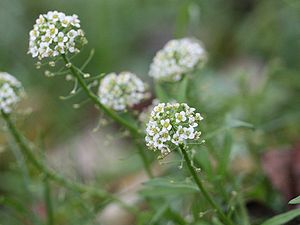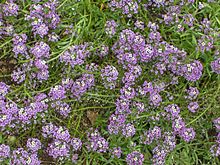Beach silver herb
| Beach silver herb | ||||||||||||
|---|---|---|---|---|---|---|---|---|---|---|---|---|

Beach silverwort ( Lobularia maritima ) |
||||||||||||
| Systematics | ||||||||||||
|
||||||||||||
| Scientific name | ||||||||||||
| Lobularia maritima | ||||||||||||
| ( L. ) Desv. |
The beach silver herb ( Lobularia maritima ), also called beach cress , stone herb or aroma stone rich , is a species from the cruciferous family . It is an ornamental plant that is often cultivated and by self-sowing it can keep in the same location for many years.
description
The beach silver herb is an annual to perennial herbaceous plant that is about 10 to 40 cm tall. It forms a gray-greenish-colored, ascending stem, which is more or less densely covered with pressed, two-armed, compass-needle-shaped hair. Its entire, obovate to linear leaves are about 2.5 to 4 cm long.
The small, aromatic, fragrant single flowers are in an initially dense cluster that later becomes looser. The whitish or rarely purple colored petals are about 3 mm long. The round to obovate pods are 2 to 3 mm long and contain one seed per compartment.
The beach silver herb can bloom all year round in the Mediterranean region. In Central Europe, the flowering period is between June and December.
The number of chromosomes is 2n = 24.
Occurrence
The natural range of the beach silver herb is in the western Mediterranean area, where it is found on the European mainland of Portugal , Spain , southern France and western and southern Italy , on the Balearic Islands , Corsica , Sardinia and Malta as well as in Morocco , Algeria , and Tunisia Libya occurs. It has been introduced and widely naturalized in western, south-eastern and central Europe, in eastern and southern Africa, on the Canary Islands , Azores and Madeira (where many authors consider it native), in North and South America, Australia and New Zealand .
The beach silverweed occurs mostly near the coast on sandy beaches, on solidified dunes, in pine forest clearings, juniper stands and macchia on sandy soil, on stony slopes, limestone cliffs by the sea and similar habitats at altitudes of up to 1200 (exceptionally up to 2000) m.
In Central Europe , the beach silver herb is a naturalized neophyte . There the plant, which mostly comes from gardens, occurs mainly in ruderal corridors and along streets.
use
The beach silver herb is widespread in sunny locations and on calcareous soils in borders, rock gardens and flower boxes as a ground cover, cut flower, for edging and as bee food or scented plant. There are several varieties with white, pink, purple or purple flowers and yellow or white striped leaves.
literature
- Henning Haeupler, Thomas Muer: picture atlas of the fern and flowering plants of Germany . Ed .: Federal Agency for Nature Conservation (= The fern and flowering plants of Germany . Volume 2 ). Eugen Ulmer, Stuttgart (Hohenheim) 2000, ISBN 3-8001-3364-4 , pp. 173 .
- Eckehart J. Jäger, Klaus Werner (Ed.): Excursion flora from Germany . Founded by Werner Rothmaler. 10th edited edition. tape 4 : Vascular Plants: Critical Volume . Elsevier, Spektrum Akademischer Verlag, Munich / Heidelberg 2005, ISBN 3-8274-1496-2 , p. 274 .
- Franz Fukarek , Heinz executioner : Flora of Mecklenburg-Western Pomerania. Fern and flowering plants . Weissdorn, Jena 2006, ISBN 3-936055-07-6 , p. 129 .
Individual evidence
- ↑ a b R. B. Fernandes: Lobularia . In: Santiago Castroviejo, Carlos Aedo, César Gómez Campo, Manuel Laínz, Pedro Montserrat, Ramón Morales, Félix Muñoz Garmendia, Gonzalo Nieto Feliner, Enrique Rico, Salvador Talavera, Luis Villar (eds.): Flora Ibérica. Plantas vasculares de la Península Ibérica e Islas Baleares . Vol. IV. Cruciferae – Monotropaceae . Real Jardín Botánico, CSIC, Madrid 1993, ISBN 84-00-07385-1 , p. 196-200 .
- ^ Erich Oberdorfer : Plant-sociological excursion flora for Germany and neighboring areas . With the collaboration of Angelika Schwabe and Theo Müller. 8th, heavily revised and expanded edition. Eugen Ulmer, Stuttgart (Hohenheim) 2001, ISBN 3-8001-3131-5 , pp. 455 .
- ↑ Liv Borgen: Lobularia (Cruciferae). A biosystematic study with special reference to the Macaronesian region (= Opera Botanica. Volume 91). Council for Nordic Publications in Botany, Copenhagen 1987, ISBN 87-88702-20-0 , pp. 84-86.
- ↑ Gordon Cheers: Botanica: The ABC of Plants. 10,000 species in text and images. German edition. Tandem, Cologne 2003, ISBN 3-89731-900-4 , p. 538.
- ↑ Eckehart J. Jäger, Friedrich Ebel, Peter Hanelt, Gerd K. Müller (eds.): Exkursionsflora von Deutschland . Founded by Werner Rothmaler. tape 5 : Herbaceous ornamental and useful plants . Springer, Spektrum Akademischer Verlag, Berlin / Heidelberg 2008, ISBN 978-3-8274-0918-8 , pp. 245 .
Web links
- Beach silver herb. In: FloraWeb.de.
- Distribution map for Germany. In: Floraweb .
- Lobularia maritima (L.) Desv. In: Info Flora , the national data and information center for Swiss flora . Retrieved October 27, 2015.
- Thomas Meyer: Data sheet with identification key and photos at Flora-de: Flora von Deutschland (old name of the website: Flowers in Swabia )



